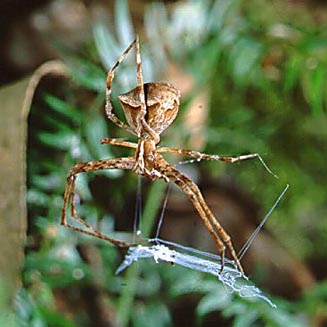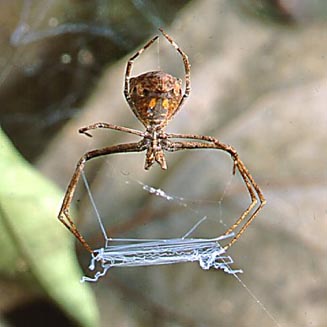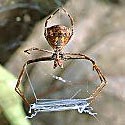|
Family: Deinopidae (net-casting spiders)
Life
> Eukaryotes
>
Opisthokonta >
Metazoa
(animals) > Bilateria > Ecdysozoa > Panarthropoda > Tritocerebra >
Arthropoda > Arachnomorpha > Cheliceriformes > Chelicerata > Euchelicerata
> Arachnida > Araneae
> Araneomorpha
 |
 |
| Net-casting spider,
Avellopsis capensis. |
|
The Deinopidae, or net-casting spiders are not commonly
encountered but illustrate an extremely interesting method of web manipulation
for catching prey. They could have been called 'retiarius' spiders, a name for
Roman gladiators who trapped their opponents with nets.
The family name and genus, Deinopis, is derived from
the Greek "deinos" means "fearful" and "opis" means "appearance" hense the
family name "ogre-faced" spiders.
They are harmless to man.
There are 4 genera with a worldwide distribution. Three
genera occur in South Africa; Deinopis (the Ogre-faced spider) tropical
and subtropical areas, Menneus (the Humped-back spider) that are found in
bushveld areas and Avellopsis (the Camel-backed spider), a Western Cape
endemic.
The eyes of the deinopids are arranged in three rows,
similar to some pisaurids, with the
anterior laterals situated ventrally (underneath) on lateral projections. The
posterior median eyes of Deinopis are very large and similar to those of
the salticids. However, instead of the
visual resolution of the salticids, The eyes of Deinopis are adapted for
low light. The posterior median eyes of Menneus and Avellopsis are
smaller than those of Deinopis, only twice the size of their other eyes.
Deinopids are unique in that they actively use and
manipulate a web to capture prey. First a scaffold web is constructed and
attached to the vegetation over an area where prey will pass. The spider then
positions itself with its head up and using a comb-like structure (cribellum) on
the tibia of its hind legs, it combs out cribellate silk from a special
silk-producing organ called the calamistrum. The calamistrum is a cream coloured
band about 1.5 to 2 mm long and about 0.2 to 0.5 mm wide and is situated
anterior to the spinnerets, viewed from below. It consists of 20 000 to 40 000
spigots (silk-producing organs), each producing a very fine strand of silk. The
silk is combed out onto the normal silk strands of what will be the capture net
and has a woolly appearance. In fact, the silk looks like this as it is in a
relaxed form, like a relaxed rubber band and has a 400 to 600% stretch capacity.
The rectangular capture net made of this crumpled silk has no adhesive capture
ability but relies on entangling properties instead - much like Velcro, where
the net tangles with projections on the prey's body.
When the net is ready the spider re-orientates itself on
the scaffold web with the head facing down, grasps the net by the four corners
with the four front legs, gives it a few stretches, and then relaxes the net and
waits for prey. For walking prey, the net is held horizontally or vertically
over the substrate and when flying prey is detected, the net is flicked
backwards, over the carapace, still in a vertical or horizontal position. Visual
senses are used to detect walking prey such as cockroaches, ants and even
spiders but vibration senses are used to detect flying insects, moths being the
most common prey.
When prey is detected, the spider propels itself forward,
stretching the net further and then suddenly releasing the tension, although not
letting go of the net. The net contracts and ensnares the prey. Once captured,
the prey is then secured further with silk fed from the spider's spinnerets with
the hind legs. While the scaffold net is reused each night, the capture net is
used only once. A new capture net is constructed each evening and in the morning
it is simply rolled into a ball and eaten.
During the day the cryptic colouring allows Deinopis
and Menneus to retire camouflaged, stretched out against tree bark while
Avellopsis retires to leaf-litter or moss covered rocks.
Genera indigenous to southern Africa
Avellopsis
Avellopsis capensis is the only
species in this monotypic genus and is endemic to the Western Cape.
Avellopsis has two lateral pointed humps on the abdomen resulting in a
triangular shape. It is 6 mm long and is the most bulky of the three genera. |
 |
Deinopis
Cryptically coloured in greys and browns, Deinopis
is recognizable by its enormous posterior median eyes and elongated 20mm
long body. These eyes are much smaller in Menneus and Avellopsis.
These posterior median eyes are similar to the anterior median eyes of the
salticids. However, instead of the
visual resolution of the salticids telescopic eyes, the eyes of Deinopis are
wide angled and adapted for low light. A pantropical genus it occurs in the
subtropical north-east of South Africa. |
|
Menneus
Menneus has a slender 11 mm long body with a single hump situated to
one side of the abdomen (not in the centre) and has extremely long anterior
legs. It is an Afrotropical genus with three species distributed in east,
central and southern Africa. Menneus camelus can be found in the
eastern half of South Africa as far south as the Eastern Cape. and appears
to be synanthropic (associated with human dwellings) in Pretoria where it is
often found sheltering on window frames. In nature it normally occurs on
grass or the branches of shrubs in savanna, grassland and fynbos where it is
well concealed lying along the plant stems. |
|
Text and images by Norman Larsen
©. |
